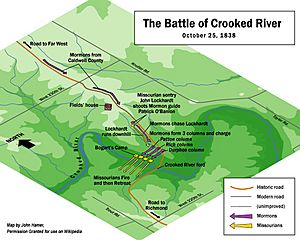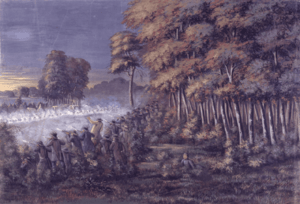David W. Patten facts for kids
Quick facts for kids David W. Patten |
|
|---|---|
| Quorum of the Twelve Apostles | |
| February 15, 1835 – October 25, 1838 | |
| Latter Day Saint Apostle | |
| February 15, 1835 – October 25, 1838 | |
| Reason | Initial organization of Quorum of the Twelve |
| Reorganization at end of term |
No apostles immediately ordained |
| Personal details | |
| Born | David Wyman Patten November 14, 1799 Vermont |
| Died | October 25, 1838 (aged 38) Ray County, Missouri |
David Wyman Patten (born November 14, 1799 – died October 25, 1838) was an important early leader in the Latter Day Saint movement. He was one of the first members of the Quorum of the Twelve Apostles, a leading group in the church. He died during a conflict called the Battle of Crooked River. Members of The Church of Jesus Christ of Latter-day Saints (often called the Church of Jesus Christ) see him as a martyr, meaning he died for his beliefs. His name is mentioned in two sections of the Church of Jesus Christ's Doctrine and Covenants, which is a book of scriptures.
Contents
David Patten's Early Life
David Patten was born in Vermont to Benoni and Edith Cole Patten. He was the 11th of 13 children. When he was young, his family moved to Theresa, New York. Later, as a teenager, he moved to Dundee, Michigan.
In 1828, at age 28, David married Phoebe Ann Babcock. They did not have any children who lived to adulthood. During this time, David was part of a local Methodist church. However, he often felt that there wasn't a "true religion" on Earth yet.
How David Patten Joined the Church
In 1830, David Patten heard about the new book called the Book of Mormon. He was very curious and wanted to read it. That summer, he read the introduction and the "Testimony of the Three Witnesses" section in the book.
Two years later, David learned that his brother, John, had joined the Church of Christ (the original name of the church started by Joseph Smith). David was excited! He rode about 300 miles to his brother's home in Fairplay, Indiana, to learn more. On June 15, 1832, David Patten was baptized by his brother.
Serving Missions and Helping the Church
David Patten served many short missions for the church. He was one of the first missionaries to preach in the southern United States.
Just two days after his baptism, David was made an elder. He was then sent on a mission to Michigan Territory. He traveled with another new church member, Joseph Wood. For 23 days, they traveled without much food or money. They relied on kind families for help. During this mission, David baptized his wife, Phoebe.
David Patten was known for his ability to heal people through faith. Abraham O. Smoot, another early church member, said that David's prayers for the sick were always answered. David himself wrote about healing a man whose hand was burned and another who had eye pain.
On September 2, 1832, David was made a high priest by Hyrum Smith.
Missions to the East Coast
In late 1832, David Patten and other missionaries were sent to the east coast. This was because Joseph Smith had received a special message (a revelation) telling them to go. Over the next few months, David traveled with other missionaries like John Murdock and William Smith. He preached in Ohio, Pennsylvania, and New York.
He returned home on February 15, 1833. Within a month, he was called on his third mission. This time, he went to preach near Theresa, New York, where his mother and some of his siblings lived. David left on March 25, 1833, with Reynolds Cahoon. As they traveled, they visited church groups and told them to move to Kirtland, Ohio, which was the church headquarters.
During one visit in Avon, New York, a man started bothering their meeting. David told him to be quiet. When the man refused, David said, "In the name of the Lord, I will!" He then picked the man up and reportedly threw him about ten feet into a wood pile! This story became a popular tale among early church members.
By May 1833, David and his companion arrived in Theresa. After preaching for a few weeks, on May 20, 1833, David's mother, two brothers (Ira and Archibald), and two sisters (Polly and Betsy) were baptized. David then traveled south to Henderson, New York, where he preached and helped 80 people join the church. After that, he returned to Kirtland. He helped build the Kirtland Temple and moved his family from Michigan to Ohio.
David Patten served 12 short missions in the eastern United States between 1832 and 1834. He faced challenges from angry groups but helped start many new church branches.
Nancy Alexander Tracy, an early church member, described David Patten: "I could at a glance see the noble spirit he possessed beaming in his countenance, and when he began to speak it was with such force and power. Before he was half through I could have borne my testimony of the truth of the gospel and doctrine he was preaching."
Becoming an Apostle
David Patten became one of the first apostles of the Church of the Latter Day Saints on February 15, 1835. He was given this special calling by Oliver Cowdery, David Whitmer, and Martin Harris, who are known as the Three Witnesses. He served as an apostle until he died in 1838.
In late 1836, David Patten moved to Far West, Missouri. On February 10, 1838, he and Thomas B. Marsh were asked to lead the church in Missouri temporarily. This was until Joseph Smith and his helper Sidney Rigdon returned. Later, David Patten became an assistant to Thomas B. Marsh, along with Brigham Young. Church members in Missouri started calling David Patten "Captain Fear-Not" because he was so brave.
In a scripture called Doctrine and Covenants section 114, given on April 17, 1838, David Patten was told to serve another mission.
The Story of Meeting Cain
David Patten is linked to a famous story in Mormon folklore. After David's death, Abraham O. Smoot shared a story that David Patten told. David said he met a very tall, hairy, dark-skinned man in Paris, Tennessee. This man claimed to be Cain from the Bible. The story says Cain had tried to die many times but couldn't, and that his purpose was to harm people's souls. This story was later mentioned in a popular book for members of the Church of Jesus Christ.
The Battle of Crooked River
David Patten died from injuries he received in the Battle of Crooked River. This battle happened because of growing problems between the Mormon settlers and other groups in Missouri. As tensions grew, a group of state militia members took three Mormon men on October 24, 1838.
In response, David Patten led a group of Mormon men to rescue them. Before dawn on October 25, as the Mormon group got close to where the state militia was camped, a guard fired a shot. The shot hit Patrick O'Bannion, one of David's guides, and badly wounded him. David Patten shouted, "God and liberty!" and led his men into the attack.
In the battle, 16 people were hurt, and four died. David Patten was one of those who died. He was leading the Mormon group and was shot in his stomach. The three kidnapped men were rescued.
David Patten was carried from the battlefield to a nearby home. Joseph Smith, Hyrum Smith, and David's wife visited him. David told them he believed strongly in the church. When his wife saw him dying, she cried. David's last words to her were, "Whatever you do else, O do not deny the faith." He then told others in the room, "I feel that I have kept the faith, I have finished my course, henceforth there is laid up for me a crown, which the Lord will give me." He died moments later, around 10 p.m.
About David's death, Joseph Smith said, "There lies a man who has done just as he said he would—he has laid down his life for his friends." David Patten was buried in an unmarked grave on October 27, 1838, in Far West, Missouri.
David Patten's Legacy
After David Patten's death, the Quorum of the Twelve Apostles did not have 12 members again until 1841. Other apostles were called to fill the empty spots.
Soon after the Battle of Crooked River, the governor of Missouri, Lilburn W. Boggs, issued a special order. This order led to more attacks, like the one at Haun's Mill, and eventually forced the Latter Day Saints to leave Missouri.
After David Patten died, Wilford Woodruff, another church leader, wrote about him. He said David was a "martyr for the cause of God" and would receive a special reward. He described David as a man of great faith and power, who was very brave.
In Doctrine and Covenants section 124, a revelation states, "David Patten I have taken unto myself; behold, his priesthood no man taketh from him." This means his special calling as an apostle would always be his.




